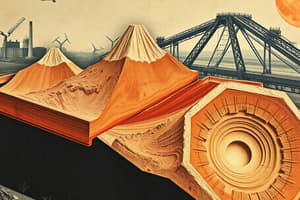Podcast
Questions and Answers
Which type of plate boundary is formed when two plates move away from each other?
Which type of plate boundary is formed when two plates move away from each other?
- Transform
- Subduction
- Divergent (correct)
- Convergent
What type of stress produces a normal fault?
What type of stress produces a normal fault?
- Tension (correct)
- Compression
- None of the above
- Shearing
What is the difference between effusive and explosive volcanic eruptions?
What is the difference between effusive and explosive volcanic eruptions?
- The location of the volcano
- The amount of gas and pressure (correct)
- The type of magma
- The time of day
Which type of plate boundary is formed when two plates move towards each other?
Which type of plate boundary is formed when two plates move towards each other?
What is the name of the scale used to measure earthquakes?
What is the name of the scale used to measure earthquakes?
What is the name of the part of a volcano where magma collects?
What is the name of the part of a volcano where magma collects?
What happens to rock when it undergoes tension?
What happens to rock when it undergoes tension?
What type of stress produces reverse faults?
What type of stress produces reverse faults?
What does stress do to rock?
What does stress do to rock?
Flashcards are hidden until you start studying
Study Notes
Key Concepts in Plate Tectonics, Earthquakes, Faults, and Volcanoes
- Plate tectonics theory explains how continents were once together and drifted apart, forming the giant continent Pangea, with tectonic plates moving on the asthenosphere.
- Convection currents are believed to cause Earth's plates to move, leading to different types of plate boundaries: divergent, convergent, and transform.
- As the seafloor spreads, magma fills the gap; subduction occurs when one plate slips under another.
- Different types of stress, including tension, compression, and shearing, affect rock and produce different types of faults: normal, reverse, and strike slip.
- Earthquakes are caused by the release of energy from the focus, below Earth's surface, and produce different types of waves: P waves, S waves, and surface waves.
- Seismographs record seismic waves, and the Mercalli, Richter, and Moment Magnitude scales are used to measure earthquakes.
- Geologists use different instruments to monitor faults, including creep meters, tiltmeters, laser-ranging devices, and GPS satellites.
- Most active volcanoes on land form near diverging plate boundaries and subduction zones, with volcanic belts forming along the boundaries of Earth's plates.
- A volcano has different parts, including a vent where lava and other substances exit and a magma chamber where magma collects.
- Volcanoes can erupt in different ways, from effusive to explosive, depending on the type of magma and the amount of gas and pressure.
- Volcanic eruptions can have different impacts, including lava flows, ash fall, pyroclastic flows, lahars, and gas emissions, affecting the environment, human health, and the economy.
- Scientists study plate tectonics, earthquakes, faults, and volcanoes to understand Earth's history and processes, and to mitigate the risks and hazards associated with natural disasters.
Key Concepts in Plate Tectonics, Earthquakes, Faults, and Volcanoes
- Plate tectonics theory explains how continents were once together and drifted apart, forming the giant continent Pangea, with tectonic plates moving on the asthenosphere.
- Convection currents are believed to cause Earth's plates to move, leading to different types of plate boundaries: divergent, convergent, and transform.
- As the seafloor spreads, magma fills the gap; subduction occurs when one plate slips under another.
- Different types of stress, including tension, compression, and shearing, affect rock and produce different types of faults: normal, reverse, and strike slip.
- Earthquakes are caused by the release of energy from the focus, below Earth's surface, and produce different types of waves: P waves, S waves, and surface waves.
- Seismographs record seismic waves, and the Mercalli, Richter, and Moment Magnitude scales are used to measure earthquakes.
- Geologists use different instruments to monitor faults, including creep meters, tiltmeters, laser-ranging devices, and GPS satellites.
- Most active volcanoes on land form near diverging plate boundaries and subduction zones, with volcanic belts forming along the boundaries of Earth's plates.
- A volcano has different parts, including a vent where lava and other substances exit and a magma chamber where magma collects.
- Volcanoes can erupt in different ways, from effusive to explosive, depending on the type of magma and the amount of gas and pressure.
- Volcanic eruptions can have different impacts, including lava flows, ash fall, pyroclastic flows, lahars, and gas emissions, affecting the environment, human health, and the economy.
- Scientists study plate tectonics, earthquakes, faults, and volcanoes to understand Earth's history and processes, and to mitigate the risks and hazards associated with natural disasters.
Studying That Suits You
Use AI to generate personalized quizzes and flashcards to suit your learning preferences.




